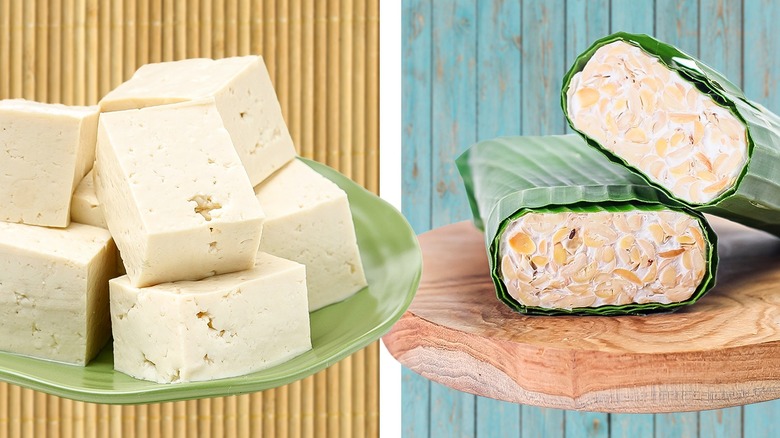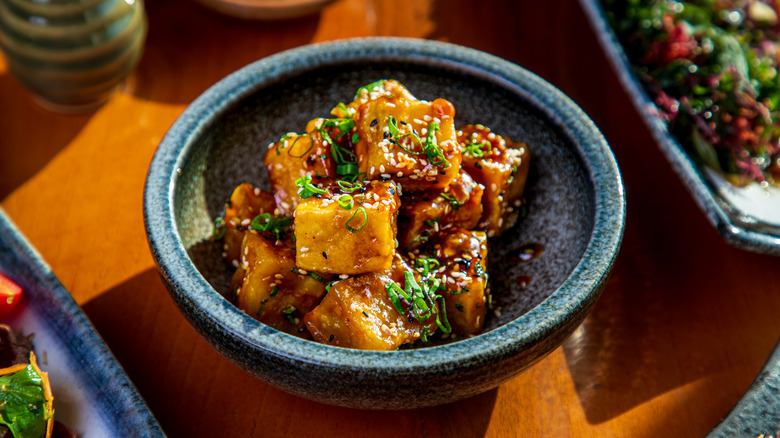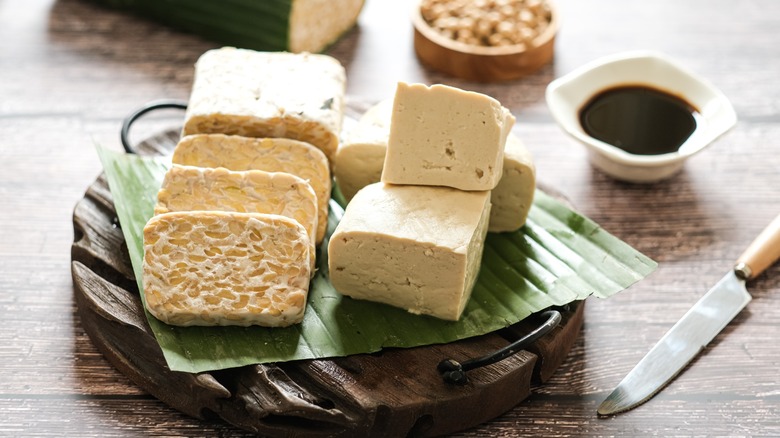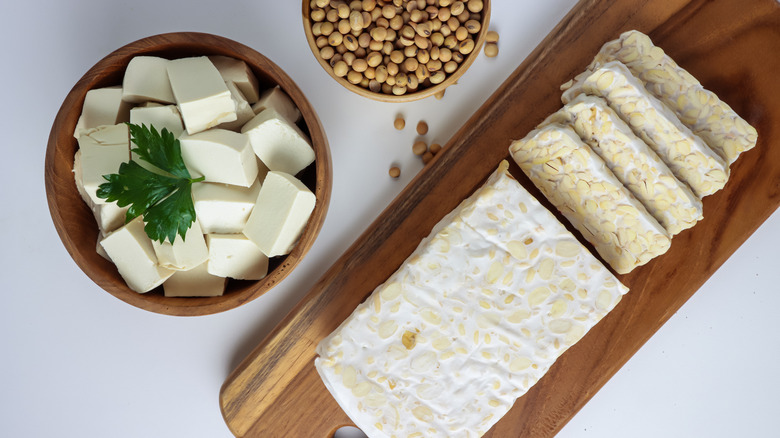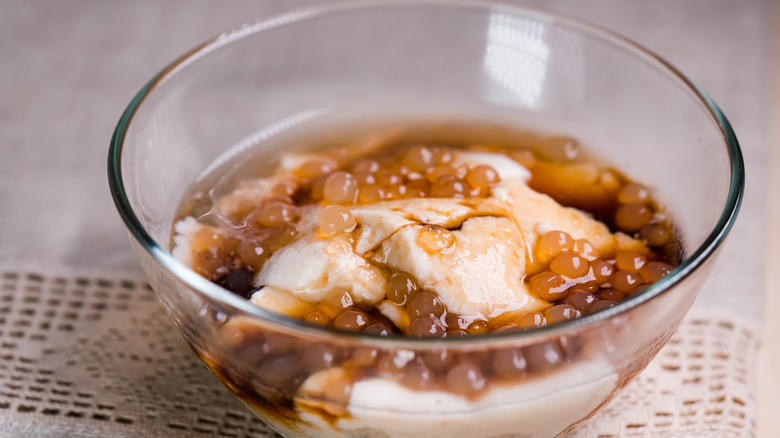Tofu Vs Tempeh: What's The Difference?
Looking for plant-based alternatives to meat has become easier over the years, thanks in part to the wider exchange of culinary information, techniques, and products across different cultures. For example, while tofu has long been known and used as a meat substitute, tempeh is also becoming a more popular option as more people discover its culinary uses and benefits. Originally from Indonesia, it's now easier to find in American grocery stores. In fact, we've featured it in our recipes for meat-free cheesesteaks and sausages.
Although both tofu and tempeh are soy-based meat alternatives, they have key differences that make substituting one for the other impractical. There are certain dishes where one would be a better ingredient than the other. For folks who have specific dietary needs, discerning the respective nutritional benefits of each food item is necessary. Tofu and tempeh also have their own distinct prep and storage methods. It's best to know their respective qualities so that the next time you're planning to cook something protein-packed yet meat-free, you'll pick the right substitute that will enhance the taste and texture of your dish.
What is tofu?
Made of soy curd or coagulated soy milk from mature white soybeans, tofu is an incredibly versatile ingredient for a variety of recipes. It can be used for every part of a meal thanks to the different textures it's available in, ranging from silken to soft to extra firm. It can even be used in a sweet treat, such as the Filipino specialty taho or soybean pudding, which has silken tofu drizzled with brown sugar syrup and topped with tapioca pearls.
Originating from China and a staple in various Asian cuisines, tofu is now a very accessible ingredient that can be found in the refrigerated section of the supermarket or grocery store. When preparing it for cooking, you must press the tofu for at least 15 minutes on your block of firm or extra firm tofu to drain the water after removing it from the packaging. Don't do this with silken tofu, though, since it falls apart when not handled gently. As for your block of soft tofu, cut it into smaller squares and lay them on paper towels. Cover them with more paper towel sheets and then firmly press down on them with your palm to remove as much moisture as possible, repeating the process to replace the water-logged sheets.
What is tempeh?
As another alternative to meat, tempeh is similarly made from soy, except manufacturers use the whole soybean and not just its curd or milk by-product. The soybeans are partially cooked and fermented first before being compressed into dense blocks. The fermentation process takes as long as 48 hours, with the soybeans kept at a temperature of 86 to 90 degrees Fahrenheit for 20 hours to allow the formation of mycelium, a white mold that looks like a network of fine threads. This mold binds the beans into a solid form.
Because of its firm consistency and chewy texture, tempeh can take on most of the cooking procedures done to meat without losing its integrity. You can pan-fry tempeh slices until they form a crispy crust, crumble it to make a vegan version of ground meat, and even skewer it for kebabs. Some manufacturers also add spices and other grains such as quinoa, flax seeds, legumes, nuts, barley, and brown rice to it, which give tempeh its distinct texture and appearance.
Tofu takes on the flavor of other ingredients while tempeh is distinctly earthy
Tofu's popularity as an alternative to meat can be credited to its ability to function like a culinary blank slate: It takes on the flavors of the other ingredients it is cooked with, making it easier for anyone to adjust to a diet that features less meat. Infuse it with a savory flavor with a marinade or steep it in a soup so it absorbs the taste of the base and seasonings you use.
In comparison, the fermentation process tempeh has gone through plus the inclusion of other grains give it an earthy, nutty flavor that might be an acquired taste for some people. Tempeh can be eaten raw as long as it has been pasteurized — inspect the package first to be sure — but some might find its natural taste too bitter. Steaming it for 10 minutes is helpful prep work that can remove that hint of bitterness. It also helps tempeh better absorb the flavors of the sauces, marinades, and spices it is cooked with while still retaining its distinct umami taste.
Tempeh has a higher protein and fiber content than tofu
An amazing fact about tempeh is how packed it is with protein. A 3-ounce serving contains 16 grams of protein, whereas tofu offers only half that amount. Indeed, it has been an inexpensive source of protein for Indonesians for centuries, with historians believing that it has been part of Javanese cuisine since the early 1600s, according to the Soy Info Center. Tempeh also packs more fiber and calories, thanks to the addition of legumes and grains, making it a more filling choice than tofu. In terms of nutrients, tempeh offers more iron and potassium, although it has only half of the amount of calcium found in tofu. It is also rich in prebiotics because of its fermentation process.
When it comes to sodium and cholesterol content, both tempeh and tofu are low in salt and cholesterol-free. They're also similarly low in fat, hence their popularity as healthy food items. Another thing both have in common is being good sources of isoflavones, which are bioactive compounds that facilitate improved cellular and blood vessel health, according to Science Direct.
Using the right type of tofu depends on your cooking needs
Although tofu starts off as soy curd, the amount of time it gets pressed dictates the solidity and texture of its finished form. Soft tofu has spent the least amount of time getting pressed while being made, thus the higher liquid content that makes it a great addition to soups, steamed dishes, and desserts. Firm and extra-firm tofu blocks, meanwhile, are easier to handle as ingredients because of the amount of liquid that has been drained from them through lengthy pressing. They're ideal for baking, stir-frying, and deep-frying, and you can also crumble them to resemble ground meat. As for silken tofu, it has only gone through a thickening process. By skipping the tofu press, it retains that soft, custard-like texture that can add creaminess to puddings and smoothies. It also makes silken tofu a great substitute for eggs whenever you're baking vegan pastries.
On the other hand, tempeh comes in a generally consistent form and texture that works well with different cooking techniques. What you might need to check when buying tempeh is the list of additional ingredients that contribute to the tempeh's overall flavor. Consider if they'll complement or clash with the flavor profile of the dish you intend to cook.
Unlike tofu, tempeh must be as dry as possible when stored
We've mentioned how tempeh is rich in prebiotics, which means it contains active bacteria when kept raw. This makes it crucial to store it properly. Unopened tempeh packages can be kept in the freezer for a month, but any leftover, uncooked blocks must be kept as dry as possible during storage. One of our tempeh tips is slicing and drying it before placing it in an air-tight container and storing it in the refrigerator so it lasts for three weeks. Slicing it makes checking for signs of spoilage easier, such as mold, a slimy texture, a change in color, and an off-putting smell.
Tofu from an opened package, on the other hand, needs moisture while in storage. Before placing it in the refrigerator, it must first be transferred into a covered container and submerged in fresh, clean water. It's important to change the water daily so the tofu remains safe to consume for three to five days. Once you're ready to cook it, pour out the water and press the tofu to drain the liquid. You can also freeze tofu for as long as three months.
